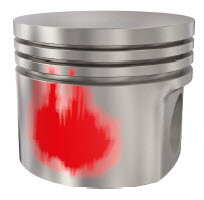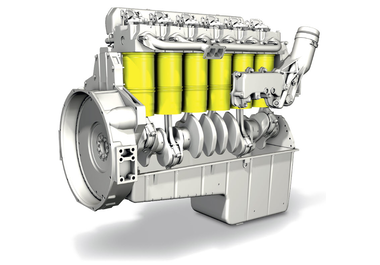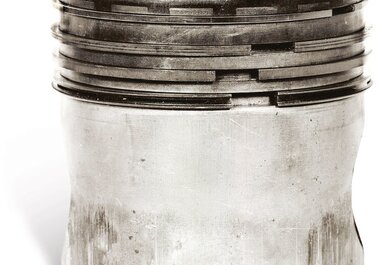
Seizures due to lack of lubrication
Information on diagnostics
What happens if the piston, piston rings and running surface of the cylinder liner rub against each other without any lubrication? What causes seizure on parts of the piston skirt? Why is it absolutely essential for the air baffles of air-cooled engines to be installed professionally? What happens if the engine is run with an over-rich mixture and what are the consequences of combustion faults? You can find out here.
General information about seizures due to lack of lubrication
Seizures due to lack of lubrication can occur generally, i.e. even if there is sufficient clearance between the cylinder and the piston. In the process the oil film breaks down (often only locally) because of the high temperatures or because of fuel flooding. In these areas, the surfaces of the piston, piston rings and cylinder running surface then rub against each other without any lubrication, which soon causes seizure with a severely worn surface.
A similar situation arises if there is an insufficient lubricating film between the piston and the cylinder due to a lack of oil.
Characteristic features of a seizure due to lack of lubrication:
If the oil film is destroyed altogether:
Seamless areas of narrow seizure marks, mainly on the piston skirt, showing a severely worn and darkly discoloured surface.
If there is a lack of oil:
Identical to those described above, apart from the discolouration of the surface. The surface of the seizure areas has an almost pure metallic finish, with no dark discolouration. As the lack of oil affects the entire surface of the cylinder, there are often seizure marks on both the pressure side and the anti-thrust side in the piston, in many cases even in the early stages.
Seizure due to lack of lubrication on the piston skirt
- Seizure marks on the piston skirt on the pressure side, which in some cases extend into the piston ring zone.
- Slight seizure marks on the anti-thrust side.
- Surface of the seizure areas is light-coloured and has an almost pure metallic finish.
Damage assessment
There was an acute lack of lubricant between the piston and the cylinder bore. The fact that the surface of the seizure areas has an almost pure metallic finish indicates that the oil film was present but significantly weakened at the time of the seizure. Due to the limited extent of the damage, this concerns a temporary lack of oil or the early stages of damage. The damage would have been even more severe if engine had been operated further.
 |
NOTE With this type of seizure due to lack of lubrication, the damage area is always located in the area of the piston skirt where the normal wear pattern would have formed on an undamaged piston after running in. |
Possible causes for the damage
Insufficient lubrication caused by:
- Insufficient engine oil.
- Oil pressure in the engine too low (oil pump, pressure relief valve, etc.): not enough oil emerges at the crankshaft bearings. This means that not enough lubricating oil is supplied to the cylinder running surface, which is lubricated with splash oil and centrifugal oil from the crankshaft.
- Failure of the oil injection jet for cooling the piston.
Piston skirt seizure on one side only without matching wear marks on the counter-side
- Severe, darkly discoloured seizure areas with a heavily worn surface on the pressure side of the piston.
- Opposite side of the piston skirt free of damage.
- Piston ring zone usually undamaged in the early stages.
Damage assessment
Possible causes for the damage
- Partial collapse of the cooling mechanism due to lack of coolant, air bubbles, dirt deposits or other malfunctions in the cooling circuit.
- On ribbed cylinders, dirt deposits on the outside can lead to localised overheating and, consequently, a breakdown of the oil film.
- On air-cooled engines: defective, missing or incorrectly installed air baffles.
- Failure of the oil injection jet for cooling the piston.
- Insufficient oil pressure: insufficient lubrication on the cylinder pressure side for connecting rods with oil injection jets.
- Insufficient lubrication on the cylinder pressure side (which is subjected to greater loads) as a result of oil dilution or oil grades that are not suited to the intended purpose.
Dry running damage due to lack of lubrication caused by fuel flooding
Narrow, sharply defined longitudinal friction marks on the piston skirt instead of the normal piston wear pattern.
Damage assessment
Unburned fuel has condensed at the cylinder running surface and diluted or washed off the load-bearing oil film. As a result, the interacting sliding parts (piston and cylinder bore) run dry against each other, which results in long, narrow friction marks. The piston ring zone usually remains undamaged.
 |
NOTE In the case of damage caused by unburned fuel, the damage occurs at the load-bearing areas on the piston skirt. These are the points at which the normal wear pattern would have formed on an undamaged piston. |
Possible causes for the damage
- Overrich engine operation and abnormal combustion caused by faults in the mixture preparation or in the ignition system.
- Insufficient compression and, as a result, incomplete combustion.
- Coldstart device defective or operated for too long (carburettor engines).
- Oil dilution caused by frequent shortdistance driving or an overly rich mixture.
Piston head seizure on a diesel piston
- Localised seizures that mainly occur on the piston top land.
- Surface of the seizure areas is rough and worn, in some cases larger pieces of material have been torn out.
Damage assessment
Due to a fault on the injection nozzle, non-atomised fuel was able to reach the cylinder wall, where it weakened the oil film to the point where the piston was running dry without any lubrication at all. As a result, the piston top land seized so severely that it was temporarily welded to the cylinder wall. This caused chunks to be torn from the piston head.
Possible causes for the damage
- Injection nozzles that are leaking, dripping after injection, clogged or the wrong type.
- Blocked injector nozzle needle due to bent injection nozzle body (incorrect tightening torque).
- Incorrect injection timing (start of delivery).
Seizure due to lack of lubrication caused by scuffed piston rings
- Score marks and burned spots on the piston ring sliding surfaces (Fig. 1 and 2).
- Longitudinal scratches on the cylinder bores (not shown).
- In the early stages: initial rubbing marks can be seen on the piston top land (Fig. 3, top right).
- In a more advanced stage: the damaged areas have spread over the entire piston (Fig. 4).
Damage assessment
This type of damage primarily occurs during the running-in phase under heavy loads, when the piston rings are not yet run in and hence do not yet provide a full seal (mostly on diesel pistons). The combustion gases streaming past the piston rings heat up the rings and the cylinder wall excessively and cause the oil film to break down.
However, abnormal combustion and increased temperatures or insufficient cooling of the piston and cylinder wall can also affect or even destroy the lubricating film. Initially this causes the piston rings to run dry without lubrication, causing burn spots. The piston also has to slide over the non-lubricated parts of the cylinder, which causes initial rubbing marks on the piston top land and subsequently leads to seizures on the entire piston skirt (Fig. 4).
Possible causes for the damage
- Excessive engine loads during the running-in phase.
- The structure of the honed cylinder surface was not perfect for good adhesion of the engine oil (squashing of the graphite veins, peak folding formation, insufficient roughness and/or incorrect honing angle).
- Unsuitable lubricating oil (incorrect grade and viscosity).
- The temperature on the cylinder running surfaces was too high (malfunctions in the cooling system or deposits in the surrounding cooling ducts).
- Abnormal combustion and the resulting increased temperatures during combustion (lean mixture, glow ignition, injection nozzles leaking or dripping after injection).
- Insufficient oil supply to the cylinder running surfaces due to insufficient quantities of splash oil and centrifugal oil from the connecting rod bearings and crankshaft bearings.

